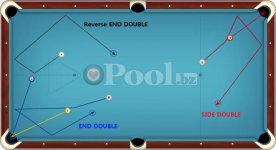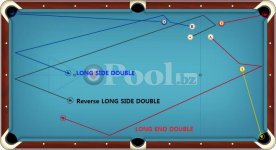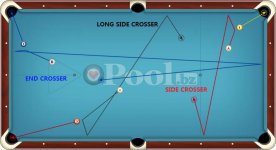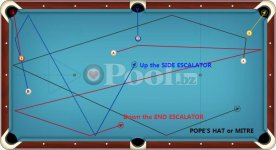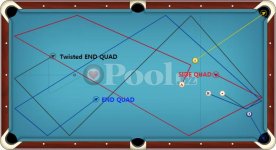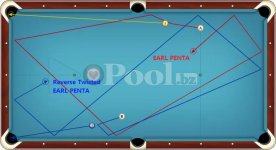[Edit: Sorry about the unintended irony in the misspelling of nomenclature in the title.]
Perhaps because I have an interest in multi-rail CB positional games, one of my frustrations, to which my signature of many years will attest, is the lack of efficient terminology available to us in describing positional routes the CB takes.
About the only useful term I've come across is 'doubling' as raised by Fred Cornerman some months ago, whereby the CB bounces off the two rails at 90 degrees adjacent to a corner pocket.
I will introduce my proposal with descriptions over several posts as I have several diagrams to include and want to keep the text near to the diagrams.
Note that I'm not interested in 1 rails positional routes here, they are easily enough explained.
So I'll start with the 2 rail shots, and the terminology for doubles that can be useful. The END DOUBLE comes off the end rail first. The side off the side rail first. The reverse indicates playing a shot with draw.
Note that you don't have to pot to that corner to double, you could come into a double from anywhere on the table, such as side pocket, far corner pockets of even from a bank.
Perhaps because I have an interest in multi-rail CB positional games, one of my frustrations, to which my signature of many years will attest, is the lack of efficient terminology available to us in describing positional routes the CB takes.
About the only useful term I've come across is 'doubling' as raised by Fred Cornerman some months ago, whereby the CB bounces off the two rails at 90 degrees adjacent to a corner pocket.
I will introduce my proposal with descriptions over several posts as I have several diagrams to include and want to keep the text near to the diagrams.
Note that I'm not interested in 1 rails positional routes here, they are easily enough explained.
So I'll start with the 2 rail shots, and the terminology for doubles that can be useful. The END DOUBLE comes off the end rail first. The side off the side rail first. The reverse indicates playing a shot with draw.
Note that you don't have to pot to that corner to double, you could come into a double from anywhere on the table, such as side pocket, far corner pockets of even from a bank.
Attachments
Last edited:
